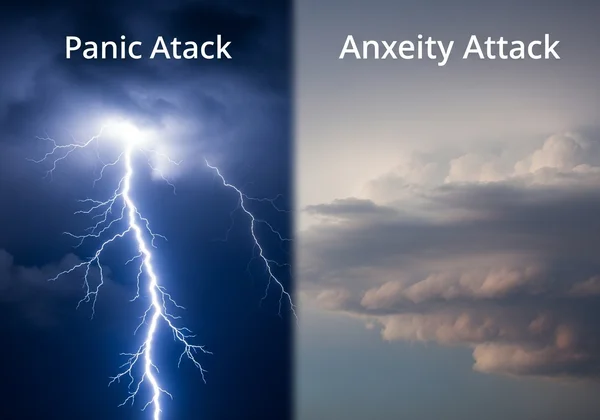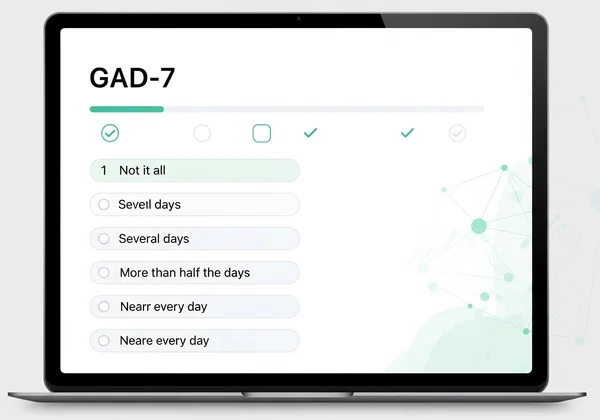GAD-7: Panic vs. Anxiety Attacks Explained
Feeling overwhelmed by intense fear or worry? It's a deeply unsettling experience, and it's easy to confuse panic attacks with anxiety attacks. Understanding the difference, however, is a crucial first step toward gaining clarity and finding the right support. Are you trying to make sense of these powerful feelings? This guide will demystify these experiences, explain their key differences, and show how a simple tool like the GAD-7 can help you understand the broader landscape of your anxiety. Taking a moment to learn can be the beginning of feeling more in control, and you can start your GAD-7 assessment here.
Panic Attack vs. Anxiety Attack: Key Distinctions
While these terms are often used interchangeably, mental health professionals recognize them as distinct events. Knowing what sets them apart helps you accurately describe your experience to a healthcare professional and find the most effective coping strategies. Let's break down the primary differences between these two intense emotional states.
What is a Panic Attack? Recognizing the Sudden Surge
A panic attack is an abrupt and overwhelming surge of intense fear or discomfort that reaches a peak within minutes. A defining feature is its sudden onset, often occurring without any obvious trigger. It can feel like it comes completely out of the blue, sometimes even waking you from sleep.
The experience is profoundly physical and can be so severe that people often believe they are having a heart attack, losing control, or even dying. This intensity is what makes panic attacks so frightening. They are a powerful, short-lived "false alarm" from your body's fight-or-flight system.
What is an Anxiety Attack? Understanding the Build-up of Worry
Unlike a panic attack, an "anxiety attack" (a term not formally defined in clinical manuals but widely understood) typically involves a gradual escalation of worry. It doesn't appear out of nowhere; instead, it builds over minutes, hours, or even days. It's often linked to a specific stressor or a period of prolonged worry, such as an upcoming exam, a conflict at work, or financial stress.
While still deeply unpleasant, the intensity of an anxiety attack may be less severe than a full-blown panic attack, but it can last much longer. The core feeling is one of dread, worry, and apprehension rather than the sheer terror that characterizes a panic attack.
Comparing Onset, Duration, and Intensity
To put it simply, think of a panic attack as a lightning strike—sudden, intense, and brief. An anxiety attack is more like a storm that slowly gathers on the horizon before settling in. Understanding these key differences is the first step toward managing your symptoms. If you're looking to gauge your general anxiety level, a confidential assessment can provide valuable insight.

Recognizing the Signs: Common Symptoms to Look For
Both experiences share some overlapping symptoms, which is why they can be so confusing. However, the specific combination, intensity, and duration of these symptoms often point to one over the other. Paying attention to what your body and mind are telling you can provide important clues.
Physical and Emotional Symptoms of a Panic Attack
Panic attacks are known for their dramatic and frightening physical symptoms. The feeling of losing control is common because the physical sensations are so powerful. Typically, a panic attack is marked by four or more of the following symptoms, which often reach their peak intensity within about 10 minutes:
- Pounding heart, palpitations, or accelerated heart rate
- Sweating and chills or hot flashes
- Trembling or shaking
- Shortness of breath or a feeling of being smothered
- A choking sensation
- Chest pain or discomfort
- Nausea or stomach distress
- Feeling dizzy, lightheaded, or faint
- Derealization (feelings of unreality) or depersonalization (being detached from oneself)
- Fear of losing control or "going crazy"
- Fear of dying
How Anxiety Attack Symptoms Manifest Differently
Anxiety, while also physical, tends to be less dramatic and more persistent. The symptoms can be a constant, nagging presence that makes it difficult to function. These manifestations often include:
- Persistent worry or a sense of dread
- Restlessness and an inability to relax
- Fatigue and sleep disturbances
- Difficulty concentrating
- Irritability
- Muscle tension, aches, and pains
- Feeling on-edge or easily startled
While a person experiencing high anxiety might feel some of the symptoms from the panic attack list, they are typically less intense and do not peak as abruptly. Getting a baseline understanding of your anxiety can be a helpful step; you can take our complimentary GAD-7 assessment today.

When Your Symptoms Warrant Professional Help
It's vital to remember that you don't have to navigate these feelings alone. If you experience recurrent panic attacks, are constantly worried about having another one, or if anxiety is interfering with your daily life, it is a clear sign to seek professional help. A mental health professional can provide an accurate diagnosis and guide you toward effective treatments like therapy and, if appropriate, medication.
The GAD-7: A First Step to Understanding Your Anxiety
While it's important to distinguish between panic and anxiety attacks, it's equally important to understand the underlying level of anxiety you might be living with. This is where the Generalized Anxiety Disorder 7-item (GAD-7) scale comes in. It's a scientifically validated, quick, and confidential tool used by professionals worldwide to screen for generalized anxiety.

Beyond Panic: How GAD-7 Assesses Generalized Anxiety
The GAD-7 doesn't specifically screen for panic disorder. Instead, it measures the severity of common anxiety symptoms over the past two weeks, such as feeling nervous, being unable to stop worrying, and feeling afraid as if something awful might happen. Since generalized anxiety often serves as the foundation from which panic and anxiety attacks can arise, understanding this baseline is incredibly useful. A higher score can indicate that your overall anxiety level warrants attention. A good way to start is by utilizing a confidential anxiety screening tool.
Interpreting Your GAD-7 Score for Deeper Insight
After answering the seven simple questions, you'll receive an instant score. This score corresponds to different levels of anxiety severity: mild, moderate, or severe. This isn't a diagnosis, but it is a powerful piece of information that offers deeper insight into your mental well-being. On our platform, you can even opt for a unique AI-powered report that provides personalized feedback on your results, helping you understand your unique strengths and challenges. Knowing your GAD-7 score can be an empowering first step.
Why the GAD-7 is a Confidential & Accessible Tool
One of the biggest barriers to seeking help is the fear of judgment. The GAD-7 assessment on our platform is completely private and anonymous. It’s a confidential tool you can use from the comfort of your own home. With support for over 15 languages, it's also highly accessible to people around the globe. This accessibility is designed to empower you with knowledge, allowing you to take that crucial first step without pressure.
Finding Clarity and Support for Your Mental Well-being
Distinguishing between a panic attack and an anxiety attack is more than just a matter of semantics—it’s about understanding your experience so you can better manage it. A panic attack is a sudden, intense surge of terror, while an anxiety attack is a more gradual build-up of worry.
Both experiences are valid and signal that your nervous system is overwhelmed. While this knowledge is empowering, the next step is to understand the context of your anxiety. Taking a GAD-7 assessment is a simple, confidential, and insightful way to measure your baseline anxiety levels. It provides you with a clear, objective starting point for a conversation with a loved one or a healthcare professional.
Your mental well-being matters. Take the first step toward clarity and understanding today. Start your assessment now and gain the insight you deserve.

Frequently Asked Questions About Anxiety & The GAD-7
Is the GAD-7 a diagnosis for panic attacks or anxiety disorders?
No, it is very important to understand that the GAD-7 is a screening tool, not a diagnostic instrument. It can indicate the severity of common anxiety symptoms, but it cannot tell you if you have a specific disorder like Panic Disorder or Generalized Anxiety Disorder. Only a qualified healthcare professional can provide an official diagnosis after a comprehensive evaluation.
What does my GAD-7 score mean in the context of my symptoms?
Your GAD-7 score provides a snapshot of your anxiety levels over the past two weeks. A score in the mild range may suggest manageable stress, while scores in the moderate to severe range indicate that your symptoms are likely causing significant distress and may be impacting your daily life. It helps contextualize your feelings and can be a great starting point for discussing your concerns with a doctor.
What should I do after getting my GAD-7 score?
After receiving your score, take a moment to reflect on it. If your score is in the moderate or severe range, or if you feel distressed regardless of the score, the best next step is to share the results with a doctor or mental health professional. The insights from the GAD-7 can help them better understand your situation and recommend appropriate support. Exploring the resources on our GAD-7 platform can also provide helpful information.
How accurate is the GAD-7 test for assessing anxiety levels?
The GAD-7 is a highly reliable and scientifically validated tool used extensively in clinical and research settings. It has been proven to be a very accurate measure for screening for generalized anxiety and assessing its severity. While no self-assessment is perfect, the GAD-7 is considered a gold standard for a quick and dependable anxiety screening.